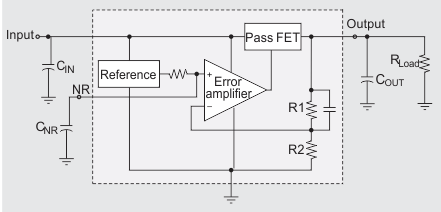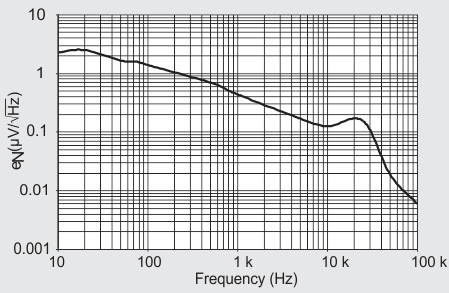SLYY203B September 2021 – April 2023 BQ25125 , LM5123-Q1 , LMR43610 , LMR43610-Q1 , LMR43620 , LMR43620-Q1 , TPS22916 , TPS3840 , TPS62840 , TPS63900 , TPS7A02
- 1
- Overview
- At a glance
- Contributors to IQ
- Why low IQ creates new challenges
- How to break low IQ barriers
-
Electrical Characteristics
- 18
- Avoiding potential system pitfalls in a low-IQ designs
- Achieving low IQ, but not losing flexibility
- Reducing external component count to lower IQ in automotive applications automotive applications
- Smart on or enable features supporting low-IQ at the Smart on or enable features supporting low-IQ at the system level
- Conclusion
- Key product categories for low IQ
Noise
Another hurdle to overcome is the increased self-noise in amplifiers that accompany lower IQ biasing. The internal blocks seen in Figure 7 contributing the most noise in LDOs are the reference system (band gap), error amplifier and resistor-divider that scales the output voltage. Figure 8 shows a typical noise profile vs frequency. The two main types of noise generated from these blocks are:
- Thermal noise (also called 4kTR noise) is a particular concern for ultra-low-IQ designs because it is linearly proportional to the resistance used. Both resistor-derived bias currents used in the error amplifier and reference blocks, and the resistance used in resistor dividers, are dominant contributors to thermal noise at frequencies >1 kHz.
- Flicker noise (also called 1/f noise) is a low-frequency noise <100 Hz, that can be mitigated by increasing the sizes of differential pairs in the reference system and error amplifiers. This larger sizing however creates obstacles for nano-power designs, as they increase self-induced leakage and add more capacitance, which slows down response times.
A simple method to evaluate the resultant noise for a given IQ is to multiply the integrated noise over the frequency range of concern and the IQ at the operating point of interest. You can usually find both numbers on device-specific data sheets.
 Figure 7 Simplified LDO block
diagram.
Figure 7 Simplified LDO block
diagram. Figure 8 Spectral noise density
example.
Figure 8 Spectral noise density
example.